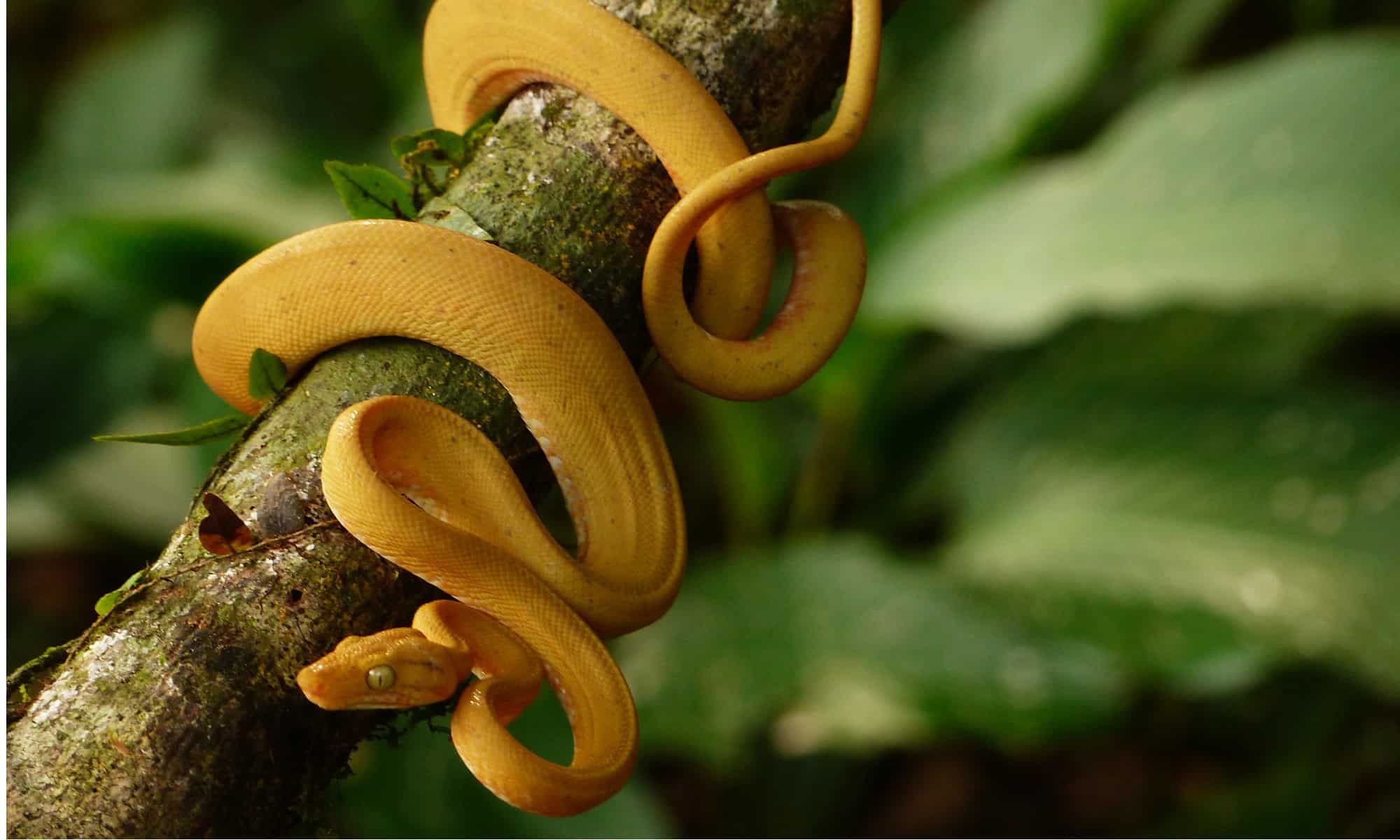
For a creature with no appendages, snakes are surprisingly fast and agile, easily slithering over rough terrain, zipping through the water, and, yes, climbing up trees. Their belly scales are similar to tire treads, which provide traction on rugged surfaces, and their intense muscles pull them up and over anywhere they need to go. Check out these eight snakes in the Americas that love to climb trees and where you can find them!
1. Golden Lancehead

The golden lancehead hunts in trees on a small island off the coast of Brazil.
The golden lancehead is a highly venomous pit viper endemic to a small island called Ila Queimada Grande, or “snake island,” off the coast of São Paulo, Brazil. This Bothrops species gets its name from its light yellowish-brown color and its head, which is elongated and comes to a point at the nose. Its island habitat is a moist tropical forest with a mild climate containing several environments, including forests, open fields, and shrubland. You will typically find the golden lancehead hunting in trees or sheltering under leaves or inside rock crevices.
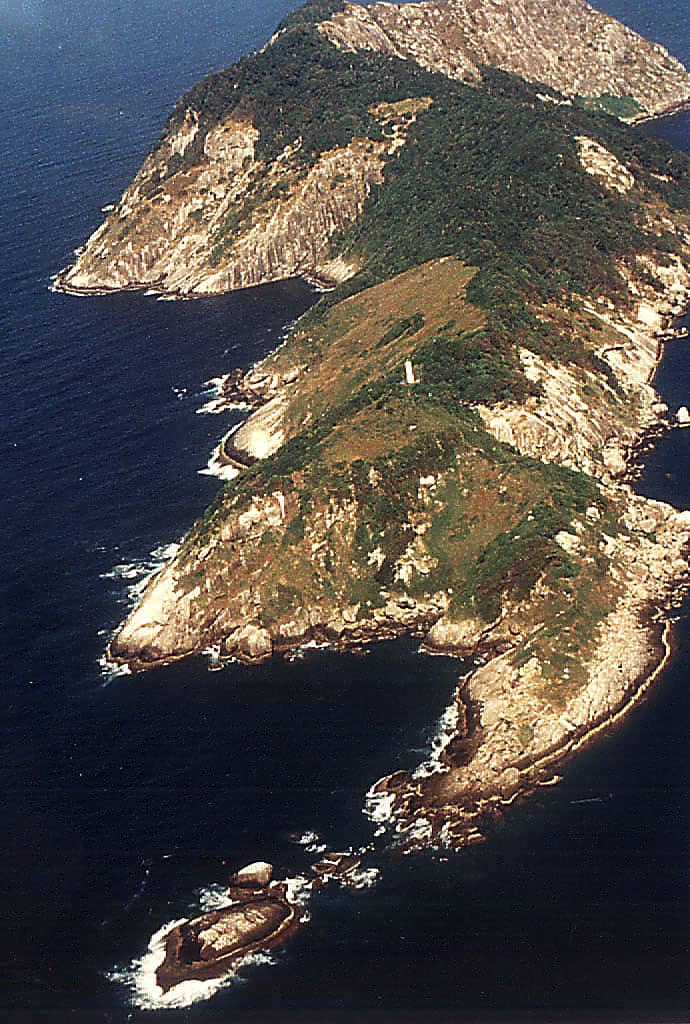
Roughly 3,000 snakes are believed to live on Snake Island off the coast of Brazil.
©Prefeitura Municipal de Itanhaém / Creative Commons – Original / License
This lancehead is one of the most venomous snakes in the world. No humans or mammals live on the secluded island, so its venom has evolved to take down ectotherms and arthropods, resulting in a much more potent toxin.
2. Western Rat Snake
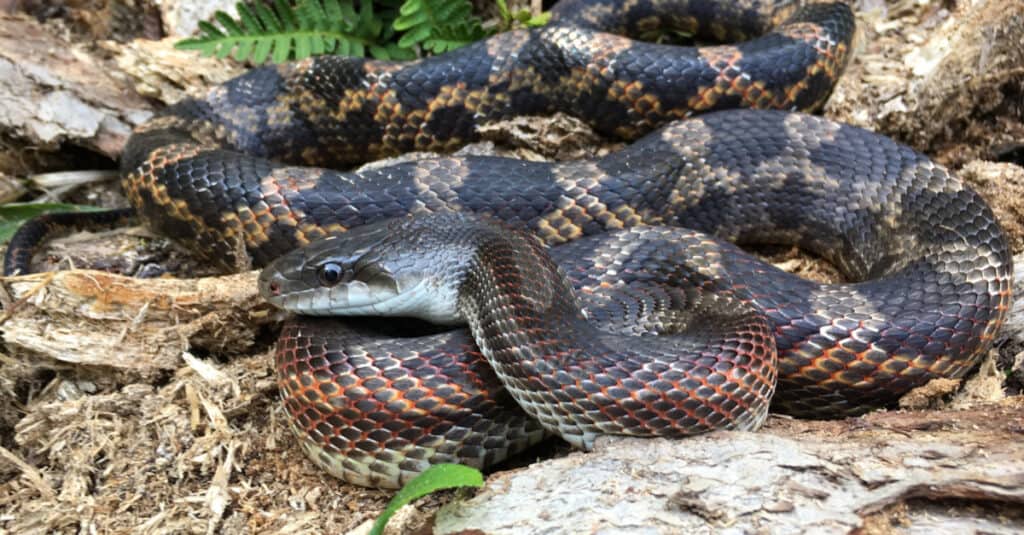
Western rat snakes are excellent climbers and spend much of their time in trees in Central North America.
©Joe Farah/Shutterstock.com
This nonvenomous Colubridae species is native to Central North America, mainly west of the Mississippi in the United States. The Western rat snake can grow quite large, reaching lengths up to eight feet, though most are between three and six.
This species lives in various habitats, including bayous, prairies, and woodlands with plenty of oak trees. They are exceptional climbers and choose to spend much of their time in the trees curled around branches. They use trees to escape predators and hunt for food, such as frogs, lizards, squirrels, and bird eggs.
3. Green Vine Snake
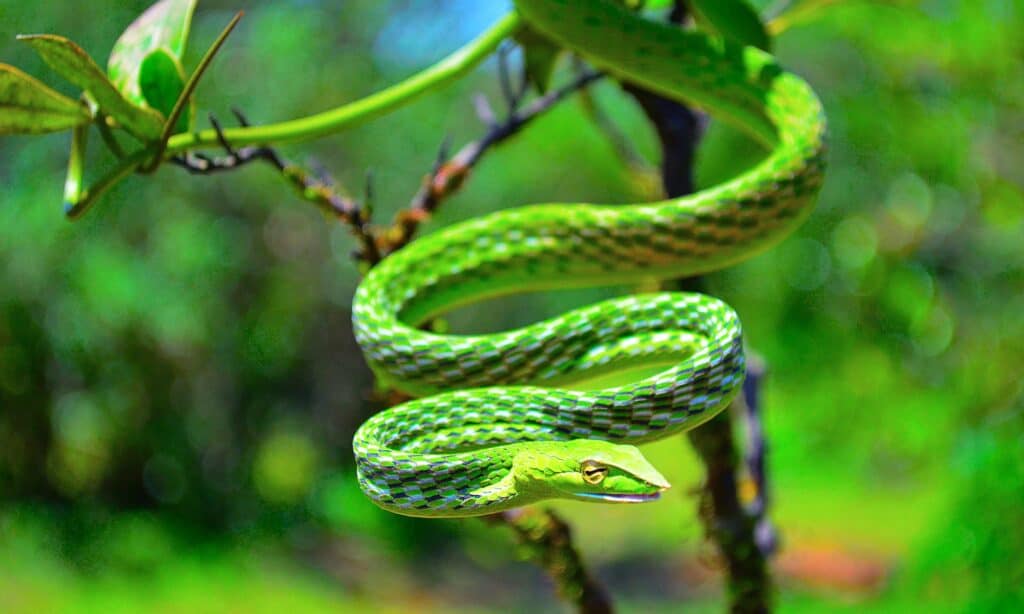
Green vine snakes are tree-dwellers native to Central and South America.
©iStock.com/ePhotocorp
The green vine snake, also known as the flatbread snake, is endemic to Central America and Northern South America. This bright green snake is long and slender, growing over six feet. It is an arboreal snake (tree-dwelling), and it uses its delicate tail to hold onto branches as it reaches for prey, including lizards, mice, and other small animals.
The green vine snake uses toxins in its two large back teeth to immobilize its prey. And while its venom is effective on small creatures, it has little to no effect on humans. This species lives in tropical dry and moist forests and along sandy beaches.
4. Amazon Tree Boa

The gorgeous Amazon tree boa loves to climb!
©iStock.com/Keyko Cruz Garcia
Amazon tree boas are native to South America, primarily inhabiting areas in the Amazon River basin. These arboreal snakes can grow to over six feet and have innumerable color and pattern variations. They have piercing yellow, gray, or red eyes with reflective membranes that shine in the light, and their tongues are black.
These boas are top predators in their environments and eat anything from lizards to bats. It is nonvenomous but will still strike with its fangs when threatened. They spend much of their lives in forest canopies, moving from tree to tree in search of food and shelter.
5. Blunthead Tree Snake
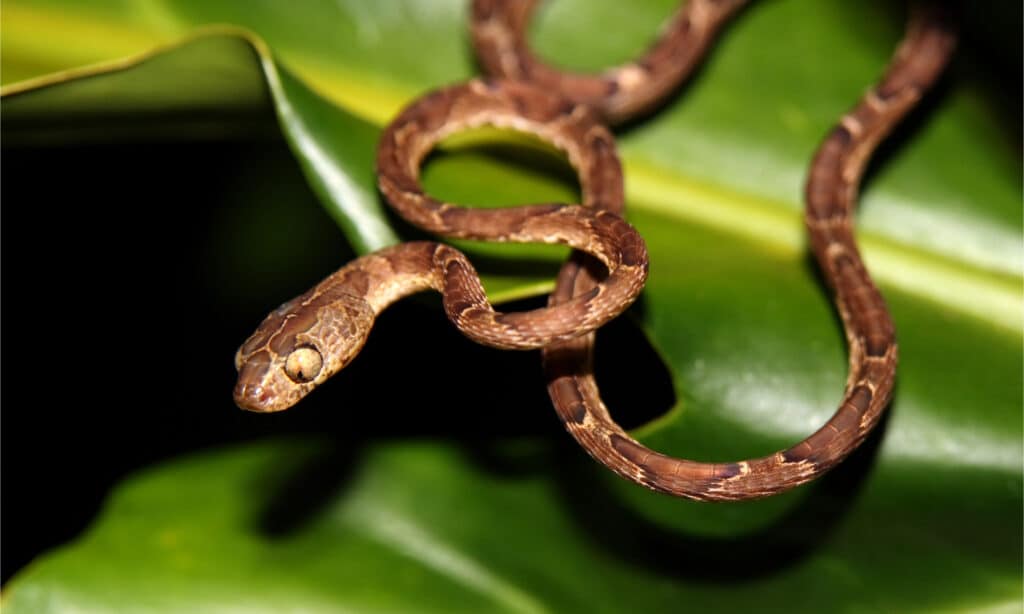
The blunthead tree snake inhabits low vegetation in shaded wet forests.
©Ryan M. Bolton/Shutterstock.com
The blunthead is a mildly venomous rear-fanged colubrid native to Mexico, Central America, and South America. This tree snake can grow over four feet and has a long, slender body with a large head. Its coloring is typically light brown with dark brown patches.
This arboreal species inhabits low vegetation like coffee trees and bromeliads in cooler moist areas, like shaded wet forests. At night, it searches for food in its dense vegetative habitat, eating mainly reptiles and amphibians. While they do possess mild venom, it is ineffectual in humans.
6. Rough Green Snake

Rough green snake on the rocks.
©iStock.com/Shoemcfly
The rough green snake, or grass snake, is a nonvenomous colubrid in North America, found primarily in the Southeastern United States and Northeastern Mexico. It’s very slender and can grow to over three feet. These snakes are bright green with a yellowish belly, which is used for camouflage in the green vegetation in their environment.
You will often find these snakes in the Piedmont and Atlantic coastal plains, but they may travel to higher elevations in the Appalachian Mountains. They like moist meadows and woodlands near water and are considered highly arboreal. It climbs in low vegetation and clings to tree limbs at night. They can also swim in nearby water sources and slither on the ground. These snakes are docile and harmless to humans.
7. Brazilian Rainbow Boa
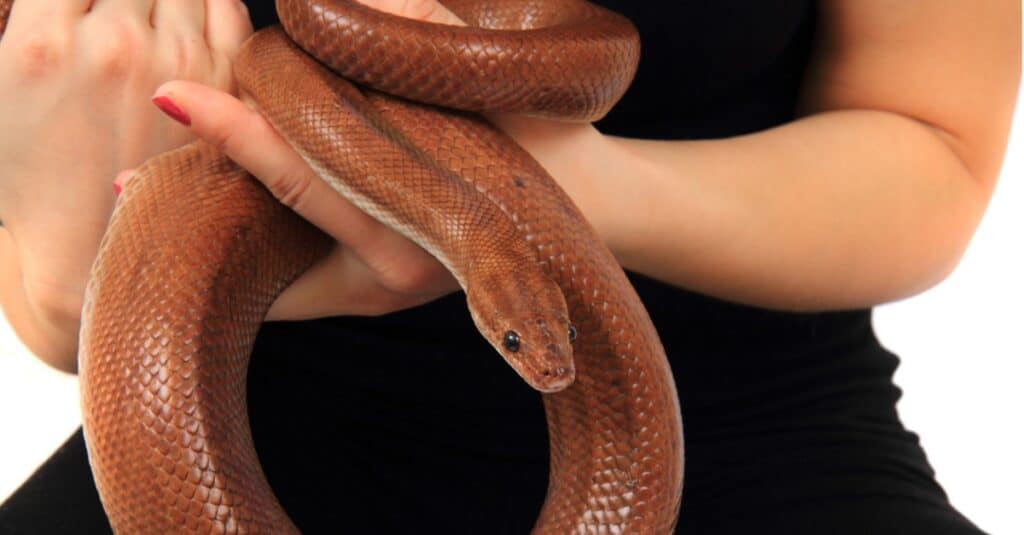
Rainbow boas live on the ground and in trees in Central and South America.
©iStock.com/jonnysek
The rainbow boa is endemic to Central and South America, where it lives in humid woodlands and rainforests but may even inhabit open savannas. This terrestrial species has an iridescent sheen that gives it a multi-colored glow like a rainbow.
Brazilian rainbow snakes are semi-arboreal, spending just as much time on the ground as they do in trees. They are also efficient swimmers, and you can often find them in various bodies of water. Boas are nonvenomous and use their bodies to constrict prey rather than bite and subdue.
8. Guatemalan Palm Viper

The Guatemalan Palm Pit Viper,
Bothriechis aurifer, is also called the Yellow-Blotched Palm Pit Viper.
©Timo Sauria/Shutterstock.com
The Guatemalan palm viper is a venomous pit viper from Southern Mexico, Guatemala, and Honduras. Their color pattern is green with yellow blotches that are bordered in black. The belly is yellowish-green is a dark stripe on the head. They can grow to a little over three feet. This species likes to wrap itself around low-lying palm trees in rainforests and cloud forests. However, not much is known about this snake or its habitat. This pit viper is venomous, but humans rarely encounter its species due to its secluded environment. The IUCN has listed this viper as Vulnerable, but it is considered at high risk for extinction.
Summary of 8 Snakes in the Americas That Love to Climb Trees:
| Name | Habitat | Location |
|---|---|---|
| Golden Lancehead | Moist, tropical forest. | Endemic to a small island, Ila Queimada Grande, off the coast of Brazil not far from São Paulo. |
| Western Rat Snake | Bayous, prairies, and woodlands with plenty of oak trees. | Central North America, mainly west of the Mississippi. |
| Green Vine Snake | Tropical dry and moist forests and along sandy beaches. | Central America and Northern South America. |
| Amazon Tree Boa | Forest canopies. | Amazon River basin. |
| Blunthead Tree Snake | Low vegetation like coffee trees and bromeliads in cooler moist areas, like shaded wet forests. | Mexico, Central America, and South America. |
| Rough Green Snake | Highly arboreal; trees in moist meadows and woodlands near water. | North America; primarily Southeastern United States and Northeastern Mexico. |
| Brazilian Rainbow Boa | Humid woodlands and rainforests; possibly open savannas. | Central and South America. |
| Guatemalan Palm Viper | Rainforests and cloud forests | Southern Mexico, Guatemala, and Honduras. |
Discover the "Monster" Snake 5X Bigger than an Anaconda
Every day A-Z Animals sends out some of the most incredible facts in the world from our free newsletter. Want to discover the 10 most beautiful snakes in the world, a "snake island" where you're never more than 3 feet from danger, or a "monster" snake 5X larger than an anaconda? Then sign up right now and you'll start receiving our daily newsletter absolutely free.
Thank you for reading! Have some feedback for us? Contact the AZ Animals editorial team.

